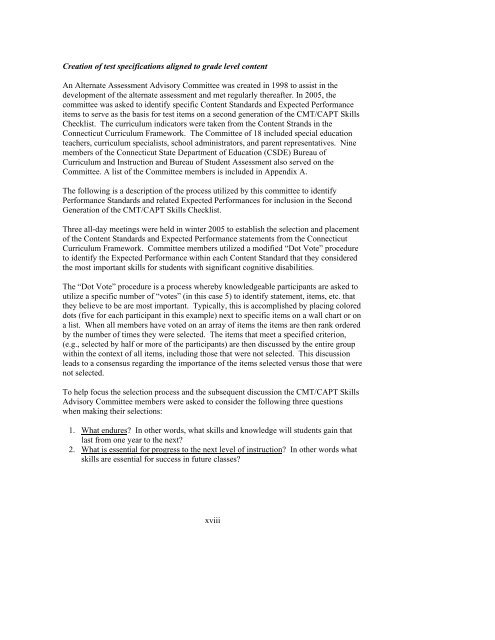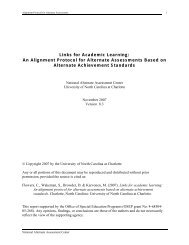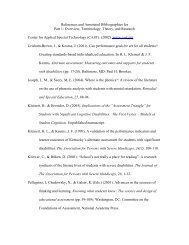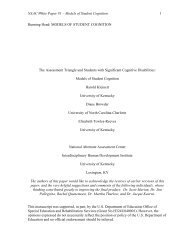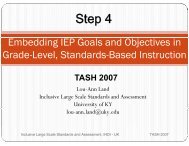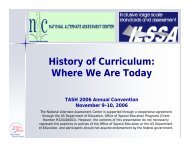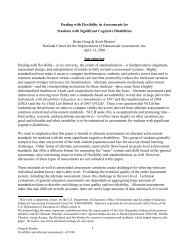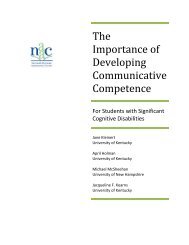Creation of test specifications aligned to grade level contentAn Alternate Assessment Advisory Committee was created in 1998 to assist in thedevelopment of the alternate assessment and met regularly thereafter. In 2005, thecommittee was asked to identify specific Content Standards and Expected Performanceitems to serve as the basis for test items on a second generation of the <strong>CMT</strong>/<strong>CAPT</strong> <strong>Skills</strong><strong>Checklist</strong>. The curriculum indicators were taken from the Content Strands in theConnecticut Curriculum Framework. The Committee of 18 included special educationteachers, curriculum specialists, school administrators, and parent representatives. Ninemembers of the Connecticut State Department of Education (CSDE) Bureau ofCurriculum and Instruction and Bureau of Student Assessment also served on theCommittee. A list of the Committee members is included in Appendix A.The following is a description of the process utilized by this committee to identifyPerformance Standards and related Expected Performances for inclusion in the SecondGeneration of the <strong>CMT</strong>/<strong>CAPT</strong> <strong>Skills</strong> <strong>Checklist</strong>.Three all-day meetings were held in winter 2005 to establish the selection and placementof the Content Standards and Expected Performance statements from the ConnecticutCurriculum Framework. Committee members utilized a modified “Dot Vote” procedureto identify the Expected Performance within each Content Standard that they consideredthe most important skills for students with significant cognitive disabilities.The “Dot Vote” procedure is a process whereby knowledgeable participants are asked toutilize a specific number of “votes” (in this case 5) to identify statement, items, etc. thatthey believe to be are most important. Typically, this is accomplished by placing coloreddots (five for each participant in this example) next to specific items on a wall chart or ona list. When all members have voted on an array of items the items are then rank orderedby the number of times they were selected. The items that meet a specified criterion,(e.g., selected by half or more of the participants) are then discussed by the entire groupwithin the context of all items, including those that were not selected. This discussionleads to a consensus regarding the importance of the items selected versus those that werenot selected.To help focus the selection process and the subsequent discussion the <strong>CMT</strong>/<strong>CAPT</strong> <strong>Skills</strong>Advisory Committee members were asked to consider the following three questionswhen making their selections:1. What endures? In other words, what skills and knowledge will students gain thatlast from one year to the next?2. What is essential for progress to the next level of instruction? In other words whatskills are essential for success in future classes?xviii
3. What contributes to understanding of other standards? In other words what are theskills that, once mastered, give a student the ability to use reasoning and thinkingskills to learn and understand other curriculum objectives? 1The Committee worked on the identification and appropriate grade placement of eachobjective. As described in the “dot vote” procedure, Committee members individuallyselected the Expected Performance items and the Content Standards they considered to be"most important" for the population of interest, i.e. students with significant cognitivedisabilities. The selected items were reviewed by the group to establish group consensusbefore the list was finalized.At subsequent item development meetings, the outcomes of the earlier work served as thebasis for a final discussion of the items selected and a finalization of the list. Inparticular, the critical questions posed to the Committee were:1. Do the Content Standards and Expected Performance selected address the full rangeof skills included in the Content Strand, i.e., from the basic knowledge andcomprehension level to the higher order thinking skills of analysis, synthesis andevaluation?2. Are the Content Standards and Expected Performances selected sufficient for theassessment of grade level skills at each grade from Grade 3 to 8, and 10?Two procedures were utilized to validate the results of the Committee’s selection andplacement of the content standards in each curriculum area. The first procedure was anindependent, expert review performed by all of the Language Arts and Mathematicscurriculum consultants at the CSDE. Each curriculum consultant, three in Language Artsand two in Mathematics, worked independently to examine the appropriateness ofdecisions made collectively by the Committee members. The results of the review led toa verification of the selection of the Content Standards and Expected Performance itemscompleted by the Committee.A second procedure compared the Committee-identified standards and performance itemswith those that had been independently identified by an urban district in Connecticutworking with a similar population. This urban district had previously completed its owncontent selection process using a similar theoretical basis 1 and focused on theConnecticut Curriculum Framework. This procedure demonstrated a high degree ofoverlap between the material developed by the district and the Committee.After the completion of both of these procedures, the CSDE considered therecommendations of the Committee to be acceptable to serve as the basis for the secondgeneration of the CTM/<strong>CAPT</strong> <strong>Skills</strong> <strong>Checklist</strong>.1 These three guiding questions are based on research by Douglas Reeves, Chairman of the Center for Performance Assessment. SeeReeves, Douglas B., Making Standards Work, 2004, Center for Performance Assessment, 317 Inverness Way South, Suite 150,Englewood Colorado, 80112 (P.47)xix
- Page 1 and 2: DRAFT: October 19, 2006CONNECTICUT
- Page 3 and 4: CMT/CAPT SKILLS CHECKLISTTECHNICAL
- Page 5 and 6: SECTION I—OVERVIEW, BACKGROUND, A
- Page 7 and 8: In addition, the purpose of Connect
- Page 9 and 10: Thus, we - the public as well as ed
- Page 11 and 12: assessment should provide similar i
- Page 13 and 14: The Second Generation CMT/CAPT Skil
- Page 15 and 16: Description of students and alterna
- Page 17 and 18: from a variety of contexts or to co
- Page 19 and 20: illustrates how to link all of the
- Page 21: Table 2TOTAL DOWNWARD EXTENSIONS BY
- Page 25 and 26: Orientation meetingIn early June 20
- Page 27 and 28: Guided item development processIn t
- Page 29 and 30: Who administers the Checklist?The C
- Page 31 and 32: • Implications for the inclusion
- Page 33 and 34: • a CD with the materials utilize
- Page 35 and 36: Video recordings selected to serve
- Page 37 and 38: Completing the CMT Skills Checklist
- Page 39 and 40: Completing the CMT Skills Checklist
- Page 41 and 42: The specific attestation in Section
- Page 43 and 44: Database audit trackingAll student
- Page 45 and 46: (A&EC), along with its sister compa
- Page 47 and 48: Appendix C) approved the standard s
- Page 49 and 50: identifies the student’s performa
- Page 51 and 52: match between the test items for su
- Page 53 and 54: Table 4Internal consistency (alpha)
- Page 55 and 56: Table 6Internal consistency (alpha)
- Page 57 and 58: APPENDIX ACMT/CAPT Skills Checklist
- Page 59 and 60: Patricia MoranCharlene Tate Nichols
- Page 61 and 62: CMT/CAPT Alternate Assessment Skill
- Page 63 and 64: Bill WalkerBeth WenzelJoanne WhiteC
- Page 65 and 66: Technical Advisory CommitteePeter B
- Page 67 and 68: Table 1ITEM BY STRAND (STANDARD): M
- Page 69 and 70: Table 3TOTAL POSSIBLE POINTS: MATH
- Page 71 and 72: Table 5TOTAL DOWNWARD EXTENSIONS: L
- Page 73 and 74:
APPENDIX EExamples of Downward Exte
- Page 75 and 76:
B. Students interpret, analyze and
- Page 77 and 78:
PARAMETERS OF ITEMS (I.E., DOWNWARD
- Page 79 and 80:
APPENDIX GStandard Terminology41
- Page 81 and 82:
APPENDIX HCMT/CAPT Skills Checklist
- Page 83 and 84:
APPENDIX JAlignment Analysis of Con
- Page 85 and 86:
TABLE OF CONTENTSIntroduction......
- Page 87 and 88:
• Pamela Brucker, Southern Connec
- Page 89 and 90:
Mathematics Framework were reformat
- Page 91 and 92:
corresponding to a standard had to
- Page 93 and 94:
• Use punctuation marks correctly
- Page 95 and 96:
Other Level 3 activities include dr
- Page 97 and 98:
Objective 2.1.a.Construct polygons
- Page 99 and 100:
The alignment analysis for grade fi
- Page 101 and 102:
The alignment analysis for grade te
- Page 103 and 104:
The alignment analysis for grade fo
- Page 105 and 106:
The alignment analysis for grade ei
- Page 107 and 108:
ReferencesValencia, S. W., & Wixson
- Page 109 and 110:
Table 1`Language Arts: Reading and
- Page 111 and 112:
Table 3Standards by Performance by
- Page 113 and 114:
Table 5Connecticut Alternate Assess
- Page 115 and 116:
APPENDIX MLearner Characteristics I
- Page 117 and 118:
APPENDIX ORelating Items from the C
- Page 119 and 120:
9/10-1 Activate prior knowledge, es
- Page 121 and 122:
APPENDIX PScope and Sequence Tables


